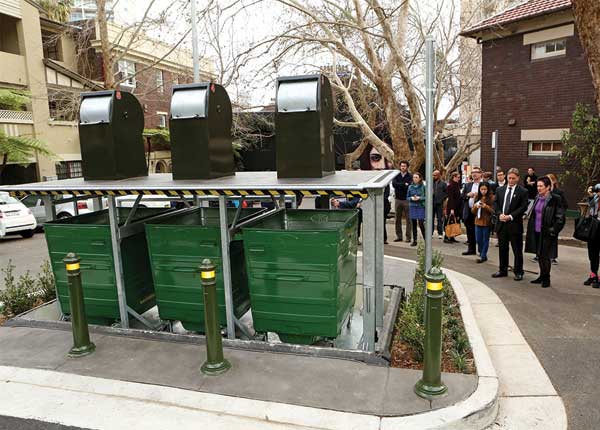The rat population of Sydney’s edgy-but-cool inner suburb of Darlinghurst is about to have its collective cunning put to the test.
The City of Sydney has unveiled a new $84,000 trial installation of a hydraulically-powered, Italian-designed sealed underground rubbish management system that spares residents of tightly packed of flats the chore dragging bins to the kerb to obstruct the footpaths and parking.
Officially launched on Monday by Lord Mayor Clover Moore, the new subterranean solution is claimed to be the first of its kind in Australia and aims to do away with the stink, clutter, noise and vermin that come with overflowing rubbish collection areas.
But the flash new bins are certainly not for everyone.
Only authorised residents armed with a PIN-code, which must first be entered into a console, can unlock the above-ground chute, similar to a mailbox, before refuse drops down into 1100 litre below-ground hoppers.
And when what used to be bin day does come around, contractors just turn a key, press a button and the platform holding the dumpsters silently rise to street level to be tipped into trucks.
In keeping with the low-noise theme, the City is so far keeping prudently quiet on any potential for financial savings that could be extracted from a reduced number of collections, always a sensitive issue.
However City of Sydney’s director of city operations, Garry Harding, said there could initially be three collections a week under the trial rather than previous often daily runs to cope with the overflow. In any event, the bins would be emptied as required.
The City is also looking to a wider return on investment, such as better hygiene, fewer pests and better amenity as considerations in the trial of the Italian-made devices from EcoPunto which are provided through local company Wastedrive.
At Monday’s demonstration and media call, Sydney’s Lord Mayor was impressed to near Alan Partridge levels by the eerie silence with which the space-age skips ascend.
“Look at this action!” Sydney’s Lord Mayor exclaimed, after first feeding the device what appeared to be a suspiciously obscured copy of the Daily Telegraph.
“This state-of-the-art waste system is a practical way to reduce clutter and beautify inner city streets. Previously residents in this small street battled with an overcrowded bin bay that attracted dumped rubbish from non-residents and quickly became an eyesore,” the Lord Mayor said.
Novelty aside, the trial is a highly important one for Lord Mayor Moore and the City of Sydney’s residents and similarly challenged municipalities.
If successful, it could pave the way for a wider underground revolution in waste management that keeps rubbish and recyclables in sealed enclosures and prevents the proliferation of vermin like, rats, feral cats, noisy myna birds and the seemingly ever present ibis – a species increasingly skilled at opening a wheely bin lids.
Although the hard evidence is yet to come in, there are strong anecdotal signs that Sydney’s warmer winter combined with denser human habitation are contributing to pest populations that in turn create real concerns for health authorities.
Royston Street had been home to some 22 wheelie bins that filled a purpose built island in the middle of an apartment-ringed cul-de-sac just a stone’s throw from the backpacker and beer hall mecca of Kings Cross.
An enduring problem for residents has been that as the central feature of the street, the bin bays resulted in plenty extra garbage being constantly and illegally dumped in addition to what apartments normally put out.
The director of supplier Wastedrive, Stewart Vincent, said he expected that other councils will be watching the Royston St trial with some interest, and he hoped the bins would “sell themselves”.
Mr Vincent said the underground bins were best suited to high density locations, such as near beaches or at public venues that attracted large crowds.
“A few would have been handy at the end of the City-to-Surf,” he said.






Why didn’t Clover Moore throw that ‘Daily Telegraph’ into a recycling bin? That’s not like her.